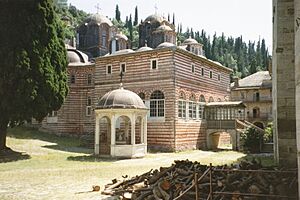Katholikon facts for kids

A katholikon (pronounced ka-tho-LEE-kon) is a very important church building in the Eastern Orthodox Church. The word comes from a Greek word meaning "where all gather together." It's often the biggest and most central church in a place.
People use the word katholikon to mean a few different things:
- It can be the main church of a diocese, which is an area managed by a bishop. This is like the main church for a whole region.
- It can be the most important church inside a monastery, where monks or nuns live and worship.
- It can also be a large church in a city where everyone from the city comes together for special, big celebrations, instead of going to their smaller local churches.
What Makes a Katholikon Special?
A katholikon is usually the largest church because it's where many people gather for major feast days throughout the year. These are big celebrations in the church calendar.
Special Features Inside
Some katholikons have unique parts inside them. For example, in Russia, it's common for a katholikon to have a smaller church in its basement. This basement church can be heated more easily during the cold winter months.
Other special features might include:
- A kathedra: This is a special throne or chair for the bishop.
- An esonarthex and exonarthex: These are inner and outer entrance halls. They are used for specific services, like the Paschal vigil (a special service before Easter) or a lity (a prayer service).
Katholikon vs. Cathedral
The word katholikon is sometimes translated into English as "cathedral." This can be a bit confusing because while a cathedral is a type of katholikon, not all katholikons are cathedrals.
For example, a bishop's main church is called a cathedral. But an Eastern Orthodox diocese might have several other very important churches that are also called katholikons, even if they aren't the bishop's main seat. The priest in charge of these important churches is usually called an archpriest.

